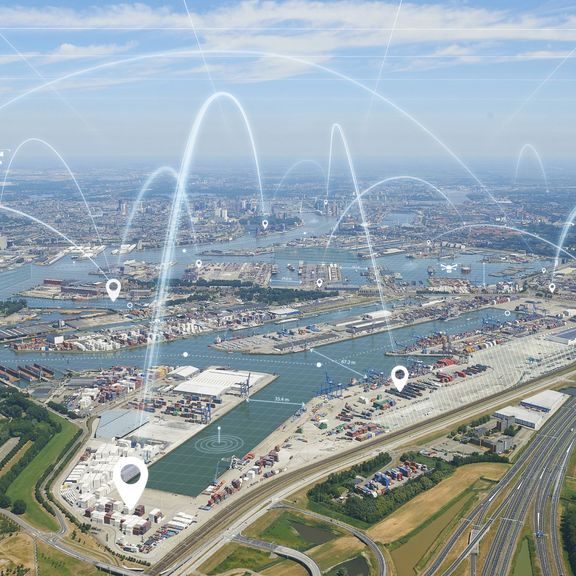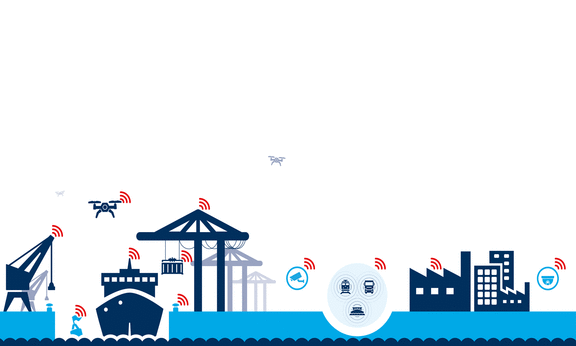
5G in the port of Rotterdam
In the port of the future, everything is connected and objects communicate with each other independently. The realisation of innovations such as these demands a robust mobile communications network. The port of Rotterdam is leveraging the power of 5G connectivity to lay a firm foundation for an innovation ecosystem, making the port area an enduringly attractive location for businesses.
Download our brochure on 5G
What is 5G?
5G is the successor to 4G and therefore the fifth generation of mobile Internet. 5G introduces businesses to new and innovative opportunities, resulting in a transformative shift in how they work and think. Consequently, this new mobile communication network is helping to make existing business processes more efficient, sustainable, secure, and cost-effective.
- Faster response time and data transfer
- More stable and reliable connections
- More users on the network at the same time
- Higher capacity
- Lower energy consumption when transmitting and receiving
- Lower costs and greater operational flexibility than optical fibre connections
As a business, what can you do with 5G?
5G mobile connectivity offers fresh opportunities for a wide variety of innovative applications and technological developments in the port of Rotterdam. Consider advancements in the Internet of Things (IoT), artificial intelligence (AI), data analytics, and the automation or robotisation of industrial production processes (for example the fully automatic container terminals).

Examples of use
Drones
Like sensors, drones in the port can be used in a range of applications. For example, the arrival of 5G allows drones to operate Beyond Visual Line of Sight (BVLOS). They can also be used for inspection tasks, surveillance, monitoring during emergencies or transporting spare parts. In the future, all drones will communicate in real time with the port’s air traffic control service.
Asset tracking & tracing
Sensors allow precise tracking of valuable assets and equipment, optimising the logistics process of containers, vehicles and vessels. The sharing of data among various partners in the logistics chain is a crucial factor in this.
Predictive maintenance
The use of sensors for life cycle management makes it possible to cut downtime of assets or specific components. Moreover, risk-based maintenance that uses sensor data and predictive models can also bring down maintenance costs.
Sensors
Sensors can be used for a wide range of applications. For instance, monitoring conditions in the surroundings including pressure, temperature, positions of vehicles or vessels, humidity and so on. The data collected by these sensors is sent in real-time to the control centres, where it can be used for process control.
Security
The use of cameras with facial recognition and AI supports the security video analysis process by helping in the detection of unauthorised individuals in restricted areas.
Unmanned cranes and vehicles
Remote-controlled cranes and self-driving vehicles can use real-time communications to boost productivity and increase safety, while also tackling future personnel shortages.
Data analytics
Smart ports generate a tremendous amount of data, which can be harnessed using advanced analytics to optimise processes, reduce costs, enhance operational safety, and increase productivity. Consequently, data-driven decisions are becoming increasingly commonplace.
Frequently asked questions
What is 5G?
5G is the successor to 4G and therefore the fifth generation of mobile Internet. 5G introduces new (innovation) opportunities, resulting in a business transformation through new ways of working and thinking. Consequently, this new mobile communication network is helping to make existing business processes more efficient, sustainable, secure, and cost-effective.
In what way is 5G different from 4G?
Where 4G is mainly focused on consumer applications and requirements, 5G is also much more aimed at business and industrial applications. The real-time control that can be achieved thanks to 5G connectivity means that many mission and business (critical) processes can be performed remotely and mobile. The speed, capacity, response time, reliability and security of 5G connectivity makes this possible.
This enables the automation of, for example, transport or other business processes. It also allows wireless connections to be established more easily and connect multiple, different objects.
Is 5G already available in the port area?
No. 5G has been available in the Netherlands since 2020, but not all frequencies can be used yet. This is due to the fact that not all radio frequencies for 5G have yet been auctioned by our government (Ministry of Economic Affairs and Climate). The auction of the 3.5 GHz band is scheduled for 2nd half 2023. Once this process has been completed, many of these frequencies will be freed up for national mobile providers. They can then build a 5G network and offer customer services. The remaining part of the frequency spectrum will remain available for local use by companies with their own private network. This frequency spectrum will become available as of December and will be issued by the National Digital Infrastructure Inspectorate (RDI) upon request. The availability of 5G in the port area therefore depends on the auction and its outcome.
What can 5G do for my organisation?
5G mobile connectivity offers fresh opportunities for a wide variety of innovative applications and technological developments in the port of Rotterdam. Consider advancements in the Internet of Things (IoT), artificial intelligence (AI), data analytics, and the automation or robotisation of industrial production processes (for example the fully automatic container terminals). In addition, predictive maintenance, autonomous vehicles and vessels, the use of drones, asset tracking & tracing and innovations in security processes all benefit from 5G connectivity.
Who is my point of contact for questions about 5G?
In principle, you can contact your Business Manager at the Port Authority for all your questions about 5G. You can also contact the Port Authority’s 5G Project Team by mail.
What can I expect from the Port Authority?
Currently, the Port Authority is putting in place the essential prerequisites for realising 5G connectivity in the port area for all clients and port users.
The Port Authority is aiming for excellent digital accessibility at the Port of Rotterdam. It has not yet been determined precisely what the Port Authority’s future role will look like in relation to 5G.
At present, the Port Authority is conducting research to determine the best strategy when it comes to the Port Authority’s role in relation to 5G.
Companies are free to apply to the Dutch Authority for Digital Infrastructure (RDI) for spectrum allocation to build a private 5G network. To avoid mutual disruption, the Port Authority is organizing consultations with companies in the port area to exchange information with each other and map out 5G connectivity requirements. Information about these meetings is available at the email address on this page.
Will 5G provide better coverage?
5G will not directly improve coverage compared to current 4G coverage. The extent to which a mobile network provides good coverage in a given area depends, among other things, on the number of antennas that can send out the necessary radio signals. It also depends on potentially disruptive factors that may play a role in the area and limit coverage. With the tall buildings, large steel cranes, vessels and other objects as well as the limited population density in the port area, this poses an additional challenge.
What is the difference between 5G and optical fibre connections?
The main difference between 5G and optical fibre is the way they transfer data and the applications for which they are used. In addition, 5G is a wireless technology suitable for mobile applications, while optical fibre connections use physical fibre-optic cables.
Optical fibre connections are often used for fixed broadband connections, such as Internet access for homes and businesses. It is suitable for sending large amounts of data over long distances. 5G, on the other hand, is designed for mobile communications and supports a wide range of applications, including mobile broadband, IoT and smart cities or ports.